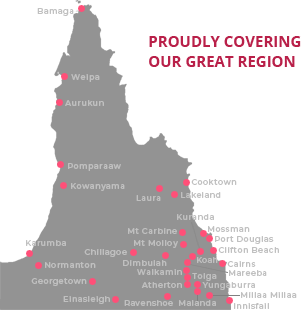General News
4 November, 2025
Platypus playground full of bacteria
YUNGABURRA’S popular platypus haven at Peterson Creek has faecal bacteria in the water that are up to 93 times higher than the safe concentration for swimming, posing not only a problem for humans, but for the long-term future of the shy, egg-laying mammal.

The findings were part of research conducted by Yungaburra Landcare Group (YLG) following concerns about the absence of platypus at the creek during certain times of the year.
The YLG conducted water sampling at Peterson Creek and at the creek’s source near Lake Eacham and had it analysed by the Cairns Regional Council Laboratory through funding from Landcare Australia.
“The results of this analysis have revealed potential issues for the long-term sustainability of platypus populations,” the YLG said in a statement. “The data also revealed a potential risk to human health from contact with the creek water.”
Safe concentrations for swimming are determined by Australia’s National Health and Medical Research Council.
The YLG analysis found the concentrations were highest during the wet season but even July 2025 water samples revealed concentrations 40 times higher, which contrasted with the far lower levels near the source of the creek.
Faecal bacteria, or thermotolerant coliforms, form when waterways have been contaminated with the faecal material of humans or other animals. It can also enter water through direct discharge of waste from mammals and birds, from agricultural and storm runoff, and from human sewage.
According to research, large quantities of faecal coliform bacteria in water may not be harmful, but can indicate a higher risk of pathogens in the water carrying diseases that cause ear infections, dysentery, viral and bacterial gastroenteritis, and hepatitis A.
“YLG is urging the TRC and relevant government agencies, in collaboration with community groups, landholders and tourism operators, to investigate and address the significant water-quality issues in Peterson Creek,” the group said.
“To ignore these issues is to put at risk our local platypus population – an iconic species already in decline elsewhere in Australia – as well as jeopardising the local tourism economy and the health of recreational users of the creek and the volunteers trying to nurture it.”
Platypus watching and other nature-related activities at Peterson Creek brings around 60,000 visitors per year from all over Australia and around the world and contribute an estimated $3 million annually to the Atherton Tablelands economy, the group said.
The YGL has placed warning signs at Peterson Creek about the human health risk of contact with the water.
“We hope to trigger some research by other organisations and we’re calling on government and communities to work together on that,” YLG president David Blair said this week.
“We are a group of about 10 to 12 members, we’re on a minuscule budget, so we’re just trying to put the word out and tell people this is something that should be looked at.”
Mr Blair said the information had been passed on to government agencies, who seem to be “pointing the finger in all different directions” over whose responsibility it is.
“The council is certainly concerned about it, and one of the council officers will probably do a test to try and work out the species of origins of the bacteria,” he said.
“My suspicion is that many of the creeks and rivers on the Tablelands will be in a fairly similar state.
“But we don’t really know, because no one has looked. Our concern was quite parochial, just our little corner of the place.”
It is not the first time Peterson Creek has been scrutinised. The YLG results confirm similar findings by a 2019/2020 water-quality study of Peterson Creek commissioned by the Tablelands Regional Council.
Also in 2020, the Queensland Department of Environment and Science identified Peterson Creek’s environmental values and the water-quality objectives required to protect them.
The YLG study reveals that those objectives were “not close to being met”.
Mr Blair said the group hoped the issue would be taken seriously.
“You can say, ‘well, we haven’t seen mass infections and deaths of people over the years, therefore this isn’t a problem’, or you could say ‘we should try and do something to reduce this because it is not a natural situation’.
“We have passed the information on to environment and natural resource management groups, so they are aware.”
Mr Blair said platypus “seem to be a fairly tolerant animal when it comes to water quality, but the things they eat seem to be less tolerant”.
He said during the wet season (when the group began to notice the absence of platypus), there were high sediment loads washed down the waterways, which could smother the platypus’ food source of bottom-dwelling creatures like crayfish and insects.
“So maybe there’s less food available and they move elsewhere. We don’t know,” Mr Blair said.
“And what effect does the faecal bacteria have on platypus?
“We can’t take this any further, but what we have done is point the way.”
A report on the project is available on the YLG’s website, https://petersoncreek.org.au/reports-documents/
To see the Water Quality objectives report go to: https://environment.qld.gov.au/__data/assets/pdf_file/0031/86908/barron-evs-wqos.pdf.



